Ijraset Journal For Research in Applied Science and Engineering Technology
- Home / Ijraset
- On This Page
- Abstract
- Introduction
- Conclusion
- References
- Copyright
Health Monitoring Systems for Military Personnel Using Sensor-based Systems
Authors: Siddhant Kumar, Sarthak Upadhyay, Sanskar Jindal, Upasana Sharma
DOI Link: https://doi.org/10.22214/ijraset.2024.62455
Certificate: View Certificate
Abstract
The integration of sensor based system and integrated technologies in healthcare has opened new avenues for monitoring and enhancing the health of military personnel, particularly in challenging operational environments. This review paper explores the evolution, applications, and challenges of health tracking systems for soldiers through the lens of IoT. We delve into the advancements in wearable devices, sensors, and data analytics that facilitate concurrent surveillance or immediate tracking and appraisal of vital signs. The paper highlights the significance of these systems in preventing injuries, ensuring timely medical intervention, and optimizing the overall well-being of soldiers during deployments. Key components, such as sensors and communication modules, are discussed, along with the critical aspects of data security and privacy. Case studies exemplify successful implementations, while the paper concludes by outlining challenges and future directions for IoT-based health tracking systems in military contexts.
Introduction
I. INTRODUCTION
The army of Republic of India stand as the one of the largest armies globally along with countries like USA and China, boasting 1,200,260 active troops and 990,980 reserve troops. A significant challenge faced by the army is the lack of timely information on injuries to personnel, potentially leading to increased death or permanent disability tolls. Research indicates that casualties often result from impairments rather than direct attacks on the field of war [1, 2]. The availability of real-time health and location information about soldiers at the control room could minimize these numbers.
Several safety issues affect soldiers, including a lack of knowledge about their current locations, challenges in persistent conveyance with the control bases during strategic confrontations, a shortage of swift intervention of medical services, and the need to operate in diverse geographical conditions. In recent decades, various advancements such as systems based on cables, Radio Frequency transceivers, Handheld transceivers, MESH Networking Protocols, and tracking equipment based on Global System for Mobile Communications have been employed for soldier tracking on the battlefield. However, these technologies have faced challenges like high installation costs, signal loss, high noise, and bulkiness. Therefore, there is a critical need for a transportable, untethered, economic system which can detect with supreme credibility to safeguard the lives of soldiers on the field of war or physical confrontation. The proposed system in this paper addresses these concerns by leveraging ubiquitous Computing and wireless sensor Networks and their esteemed concepts.
The IoT-based system proposed here enables simultaneous sustained surveillance of soldier’s well-being markers and positions. The block diagram in Fig. 1 illustrates the components of the proffered smart systems. The system monitors cardiac rate, physiological temperature, and ambient oxygen levels, along with soldiers' location tracking using GPS. The IoT facilitates the transmission of these parameters to the control headquarters and node bases, which then retrieves the locale and configuration of soldiers through satellite-based navigation. Additionally, Geolocation guidance must be provided to soldiers for correct Navigational cues during Maneuvers. Section second of this review report delves into contemporary technologies in Military Personnel Health Assessment and positioning systems. Section 3 details the operation of the proposed system, and the review report concludes in forth section, outlining anticipated investigations directions.
II. LITERATURE REVIEW
Numerous scholars and researchers have undertaken substantial efforts to examine the location and robustness of Military Personnel on Geolocation is employed to Evaluate present spatial position and orientation or Determine up- to-the-minute coordinates and orientation. Recorded sensor values and the Location tracking receiver are Harvested and treated with or compiled and operated through an the fields of war or battle. Pavan Kumar et al. [3] introduced a satellite tracking and navigation technology for monitoring Military Personnel well-being markers including vital signs and trailing their location, utilizing the AT89C51 microcontroller to collect health data.
This information was then transmitted Relaying information via GSM to the main control. Another approach proposed in [4] utilized ZigBee technology, while [5] suggested a Raspberry Pi-based method Measuring physiological functions or Surveillance of vital statistics. The consolidated data were subsequently integrated into Cloud-powered or Web-based platforms with the assistance of Embedded systems.
R. Shaikh et al. [6] presented a Synchronous, Monitoring platform with ARM processing capabilitiesfor patient’s temperature, heartbeat, and Cardiac waveform characteristics Incorporating ZigBee and GSM wireless solutions to relay updates to doctors for immediate action. Additionally, [7] reported Utilizing ZigBee in WBASNs for health and location awareness. G. Raj et al. [8] Presenting an Radio-Frequency module for gathering real- time soldier information. Furthermore, a Single-session authentication or Dynamic password system [9] was suggested for securing and authenticating Data computation or Data management. Jassas et al. [10] proposed integrating wireless sensor networks and cloud computing for real-time information processing. A Google Maps-based approach was introduced for tracking the Military personnel location or Troop coordinates. However, these systems face challenges such as costly implementation, delayed response, and the use of various biomedical sensors for observing a soldier's health parameters and surrounding environmental conditions. To address these issues, our proposed system is divided into two units: the Soldier wearable IoT technology or Smart soldier ensemble and the Centralized control station. It utilizes Physiological parameter detectors or Temperature, Pulse, and O2 level detectors specifically called as LM35 , pulse tracker and oxygen concentrations probe for continuous health Inspecting of soldiers.
Geolocation is employed to Evaluate present spatial position and orientation or Determine up- to-the-minute coordinates and orientation. Recorded sensor values and the Location tracking receiver are Harvested and treated with or compiled and operated through an ATmega328P integrated circuit or Arduino processing chip. The Preference for ATmega328P is due to its cost-effectiveness, availability, and flexible interfacing capability, making it superior to other processors used in existing systems. As a response to the challenges faced by prior systems, Real-time functionality in a mobile device based on the Emergence and suggestion of the IoT framework or Unveiling and assertion of the IoT concept in this paper, presenting A practical alternative within this context Military personnel tracking for health and location in battlefield scenarios.
III. PROPOSED SYSTEMS
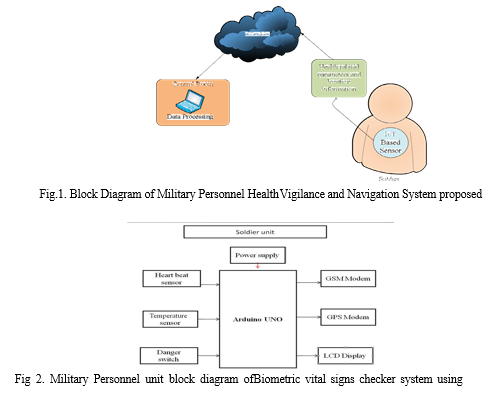
The envisioned system not only conducts health monitoring but also incorporates soldier tracking through the Internet of Things (IoT). The control room gains access to the soldier's position and orientation data from the GPS, facilitating guidance in case of directional loss. The base station utilizes IoT to retrieve the soldier's real- time status, with various tracking parameters Dispatched using a Wireless LAN module. This data is ArchivedUtilizing cloud services, accessible on the control room's PC. Authorities can promptly respond by deploying medical or rescue teams based on this information.
The system under consideration is feature-rich and adaptableseamlessly integrated Tactical gear or War fighter’s kit, with the ATmega328P processing unit serving as the central unit. The Military personnel’s unit comprises the Component lineup for data acquisition or Sensor array for monitoring (the physiological sensor, pulse rate detector, geolocation tracker, panic danger switch ,16*2 Liquid Crystal Display and wireless connection Module suite). The ATmega328P processor functions as the unit's core, executing real-time data processing and communication tasks.To enhance adaptability, threshold values for specific parameters are preprogrammed into the Arduino based on the surrounding environment and individual under observation. As a validation parameter in the proposed experiment, body temperature is considered. In the event of temperature deviation beyond the predetermined threshold, the system triggers an alert, accompanied by a buzzer sound, and transmits the data to the control room.
This comprehensive system aims Advancing soldier safety through the provision of real-time health insights and location updates or Promoting soldier well-being through constant health monitoring and accurate location updates, fostering swift and informed decision-making by military authorities.
A. The Algorithm
The devised algorithm ensures comprehensive vital signs monitoring or wearable health technology and location surveying of soldiers. This advanced monitoring infrastructure seamlessly integrates multiple components To relay instantaneous data to the control room and display pertinent information on an LCD. The key functionalities include:
- Location Tracking via GPS: The GPS receiver accurately tracks the soldier's exact location, and this data is transmitted to the control room for real-time monitoring. Simultaneously, the soldier's location is displayed on the LCD.
- Body Temperature Measurement: Utilizing the LM35 temperature sensor, the algorithm continually monitors the soldier's body temperature. An alert is triggered and relayed to the control room when the temperature crosses a predefined threshold level. This critical information is also visually displayed on the LCD, ensuring immediate attention.
- Pulse Rate Computation: The algorithm computes the soldier's pulse rate through a pulse rate sensor. If the pulse rate surpasses the predetermined threshold, an alert is activated, and the control room is notified. The computed pulse rate is also prominently displayed on the LCD for real-time health assessment.
- Oxygen Concentration Monitoring: The Grove-Gas Sensor assesses the oxygen concentration in the soldier's environment. In the event of any significant changes in environmental status, the system triggers an alert, promptly informing the base station. This feature enhances the system's responsiveness to variations in the soldier's surroundings.
- Emergency Response with Panic Button: The inclusion of a Panic Button provides soldiers with a rapid means of seeking assistance during emergency situations. Activation of the Panic Button sends an immediate alert to the control room, facilitating swift response and the deployment of necessary resources. This algorithm, characterized by its multifaceted approach to health monitoring and emergency response, aims to create a robust and adaptive system. By integrating diverse sensors and functionalities, the algorithm ensures the well- being of soldiers in various scenarios, providing timely alerts and information to facilitate swift decision-making by military authorities.
B. Hardware Description
1) Heartbeat Sensors
The heartbeat Monitoring instrument is specifically formulated for calibration or shaped for quantitation heartbeats when a finger makes contact or upon touching the surface with a finger. The computer-generated output is interfaced with the Arduino board, directly measuring BPM for cardiac beats or heart’s frequency. Employing the principle of light modulation by circulatory dynamics or Operating on the basis of vascular- induced light changes, it provides accurate pulse readings. The system sets a threshold range of 60 to 100 BPM, and any deviation from this range triggers the dissemination of or the conveyance of information to the control room.
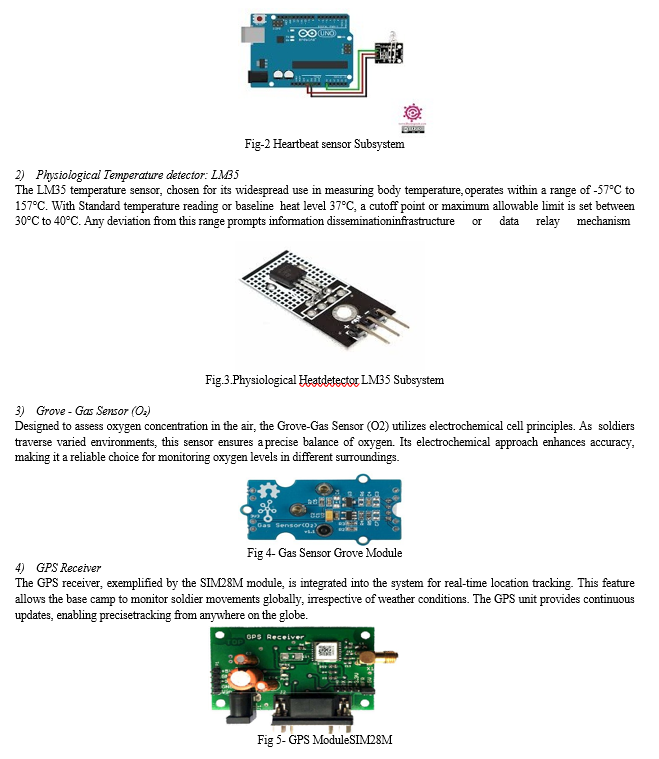
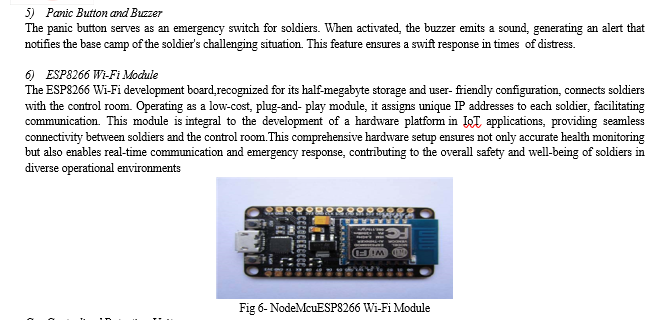
C. Centralized Detection Unit
The Metrological devices or surveying instruments seamlessly integrated with the Arduino microcontroller and Wi-Fi module, each equipped with a unique registered IP address. This configuration is pivotal for transmitting real-time information and creating a comprehensive database on the internet. The control room, leveraging the unique IP addresses assigned to each soldier, extracts real-time information from the database. The stationed officer at the base has the capability to view the soldier's current location on Google Maps and assess their present health status using a graphical user interface (GUI) page..
IV. RESULTS AND DISCUSSION
A. Geolocation detector on terminal for Serial Communication
The Geolocation transceiver calculates NMEA (National Marine Electronics Association) parameters, including (Global Positioning System Fix Data), (Geographic position, Latitude, and Longitude), (Satellite status), GPGSV (Satellites in view), (Recommended Minimum sentence C), and (Track made good and ground speed). In this context, "GP" stands for Global Position. Figure 6 illustrates the accurate location information displayed on Google Maps using NMEA data. The suggested system accurately and consistently computes the soldier's location..
NMEA stands for the National Marine Electronics Association. It is an industry-standard protocol used for communication between marine electronic devices, such as GPS receivers and navigation systems. The NMEA protocol defines a set of sentences or messages that convey information related to position, speed, time, and other relevant data.
- Global Positioning System Fix Data: This sentence provides essential information about the GPS fix, including latitude, longitude, altitude, and the time of the fix.
- Geographic position, Latitude, and Longitude):This sentence provides geographic position data, specifically latitude and longitude.
- Satellite status):This sentence conveys information about the status of the GPS satellites in view and the mode of the GPS receiver (e.g., 2D or 3D fix).
- (Satellites in view):This sentence reports the number of GPS satellites in view, their identification, elevation, azimuth, and signal strength.
- (Recommended Minimum sentence C): This sentence provides essential information for navigation, including latitude, longitude, speed over ground, course over ground, and time.
- (Track made good and ground speed): This sentence provides information about the course and speed over the ground.
In sum, NMEA is a standardized communication protocol that facilitates the exchange of critical navigation-related data between different marine electronic devices, ensuring interoperability and compatibility within the marine electronics industry.
B. Physiological Heat Detector Consequences on Terminal for Serial Communication
The LM35 body temperature sensor continuously monitors physiological heat levels, with a set threshold level of 33.6°C. If the body temperature falls below this threshold, the system triggers an alert, sending the necessary transmitting information to the control center along with the message "Soldier in Panic situation needs Help." The corresponding notification message created by the envisioned setup or the advocated approach is depicted in Fig. 7. Additionally, a the proposed comparative analysis method or the envisioned comparative study is conducted to assess the feasibility of the suggested system. Table III presents the results, clearly indicating that the recommended solution or the outlined system the superior groundbreaking option compared to present models or a forward-thinking choice relative to existing solutions.This integrated control room unit not only facilitates real-time monitoring but also provides a user-friendly interface for officers to make informed decisions based on soldiers' location and health status, thereby enhancing the effectiveness of military operations.
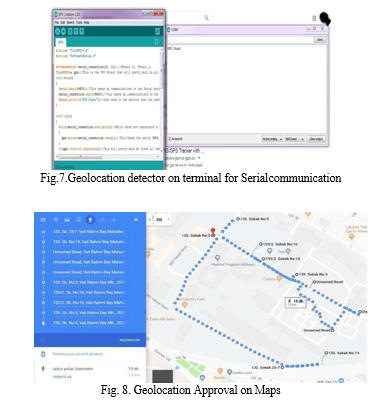
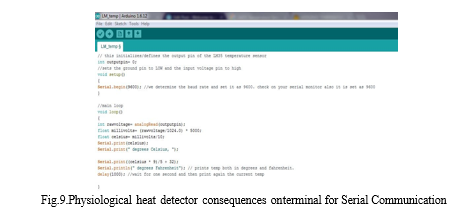
Conclusion
This Review Report presents a digitally interconnected setup or a sensor-infused system crafted for the surveillance and tracking of Military Personnel, employing the cost-effective Arduino board for efficient data processing. Biomedical sensors contribute crucial data, including Cardiac pulsation, physiological heat levels, and ecological determinants or habitat characteristics, transmitted to the control base for real-time monitoring. This technology serves as a valuable asset in accurately locating missing soldiers during critical conditions, addressing a significant challenge of military personnel going no longer accounted for or unfound. The implemented place identification system or spatial reference system enhances communication among soldiers in emergency situations and provides essential navigation information to the control room. In summary, this system emerges as a lifeguard for army personnel globally, addressing critical needs in health monitoring, communication, and location tracking. Future advancements may involve the development of a convenient Compact device with expanded sensing options to further support military personnel in various operational scenarios. The proposed IoT-based system stands as a testament to technological innovation in enhancing the safety and efficiency of military operations worldwide.
References
[1] Hock Beng Lim, Di Ma, Bang Wang, Zbigniew Kalbarczyk, Ravishankar K. Iyer, Kenneth L. Watkin (2010) “A Soldier Health Monitoring System for Military Applications” International Conference on Body Sensor Networks, pp: (246-249). [2] William Walker, A. L. Praveen Aroul, Dinesh Bhatia (2009) “Mobile Health Monitoring Systems” 31st Annual International Conference of the IEEE EMBS, Minneapolis, Minnesota, USA, pp: (5199-5202). [3] M. Pranav Sailesh, C. Vimal Kumar, B. Cecil, B. M. Mangal Deep, P. Sivraj (2014) “Smart Soldier Assistance using WSN” International Conference on Embedded Systems - (ICES 2014), IEEE, pp: (244-249). [4] P.S. Kurhe, S.S. Agrawal (2013) “Real Time Tracking and Health Monitoring System of Remote Soldier Using ARM 7”, International Journal of Engineering Trends and Technology, 4(3), pp: (311-315). [5] Shruti Nikam, Supriya Patil, Prajkta Powar, V. S. Bendre (2013) “GPS Based Soldier Tracking and Health Indication System” International Journal of Advanced Research in Electrical, Electronics and Instrumentation Engineering, 2(3), pp: (1082-1088). [6] Prof. Pravin Wararkar, Sawan Mahajan, Ashu Mahajan, Arijit Banerjee, Anchal Madankar, Ashish Sontakke (2013) “Soldier Tracking and Health Monitoring System” The International Journal of Computer Science & Applications, 2(02), pp: (81-86). [7] Govindaraj A., Dr. S. Sindhuja Banu (2013) “GPS Based Soldier Tracking and Health Indication System with Environmental Analysis”, International Journal of Enhanced Research in Science Technology & Engineering, 2(12), pp: (46-52). [8] Palve Pramod, “GPS Based Advanced Soldier Tracking With Emergency Messages & Communication System” (2014) International Journal of Advance Research in Computer Science and Management Studies, 2(6), pp: (25-32) [9] Mr. Rajdeep Limbu, Prof. V. V. Kale (2014) “GPS Based Soldier Tracking and Health Monitoring System” International Journal for Technological Research in Engineering, 1(12), pp: (1485-1488). [10] Rubina Shaikh (2012) “Real Time Health Monitoring System of Remote Patient Using Arm7” International Journal of Instrumentation, Control and Automation, 1(3-4), pp: (102-105). [11] Ekta Madhyan, Mahesh Kadam (2014) “A Unique Health Care Monitoring System Using Sensors and ZigBee Technology” International Journal of Advanced Research in Computer Science and Software Engineering, 4(6), pp: (501- 509). [12] Dr. S. S. Riaz Ahamed (2009) “The Role of ZigBee Technology in Future Data Communication System” Journal of Theoretical and Applied Information Technology, 5(2), pp: (129-135). [13] Nisha Ashok Somani, Yash Patel (2012) “ZigBee: A Low Power Wireless Technology for Industrial Applications” International Journal of Control Theory and Computer Modeling, 2(3), pp: (27-33). [14] P. Rohitha, P. Ranjeet Kumar, Prof. N. Adinarayana, Prof. T. Venkat Narayana Rao (2012) “Wireless Networking through ZigBee Technology” International Journal of Advanced Research in Computer Science and Software Engineering, 2(7) , pp: (49-54). [15] Dinesh Kumar Jaiswar, Sanjna S. Repal (2015) “Real Time Tracking and Health Monitoring of Soldiers using ZigBee Technology: a Survey” International Journal of Innovative Research in Science, Engineering and Technology, 4(7).
Copyright
Copyright © 2024 Siddhant Kumar, Sarthak Upadhyay, Sanskar Jindal, Upasana Sharma. This is an open access article distributed under the Creative Commons Attribution License, which permits unrestricted use, distribution, and reproduction in any medium, provided the original work is properly cited.

Download Paper
Paper Id : IJRASET62455
Publish Date : 2024-05-21
ISSN : 2321-9653
Publisher Name : IJRASET
DOI Link : Click Here
 Submit Paper Online
Submit Paper Online

